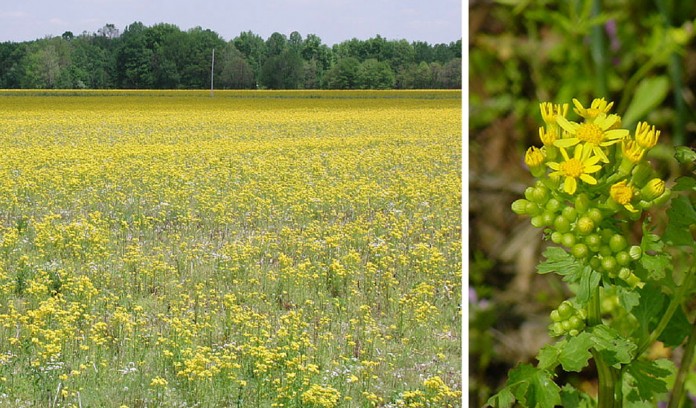
It’s that time of year again! The fields of yellow have emerged again, and cressleaf groundsel is becoming dominant in fallow and pasture fields.
You might ask “what is this cressleaf groundsel?” Cressleaf groundsel is a winter annual that becomes noticeable each spring just as the planting season kicks off. It thrives in areas with low competition, such as those found in no-till systems and pastures with poor grass and legume growth.
It’s considered to be a noxious weed in Ohio due to its aggressive growth and because it produces a chemical compound toxic to livestock and humans when consumed. It thrives in cool, wet conditions and withers as soon as the weather warms in early summer.
In the fall, cressleaf groundsel begins its annual growth cycle as a basal rosette. It becomes noticeable the following year when it bolts, producing a tall stalk with a yellow umbel-shaped inflorescence that will eventually produce the seeds. Stems are hollow and can get up to 3 feet in height.
Yellow flowers on the plant resemble daisies and seed heads are similar to those of dandelions. Since it is an annual, after it produces seeds, it will die.
Leaves, seeds and flowers of cressleaf groundsel are all toxic, which especially becomes problematic when this plant grows in hay and pasture fields where there is a greater risk of livestock consuming the plant. The plant produces alkaloids that can affect an animal’s liver, leading to chronic symptoms that include loss of appetite, wandering and sluggishness.
Preventing cressleaf groundsel from getting into fields in the first place will make management much easier in the long run. However, by the time we usually notice we have a problem, the plant is mature, producing flowers and seeds and spreading from place to place.
The best time to treat cressleaf groundsel is while it’s in the basal rosette stage in the fall. 2,4 D or a combination of 2,4-D and dicamba can provide good control of this weed applied either in the fall or early spring.
Applications made in the spring during cooler weather may not be as effective as those applied during warmer periods when the weed struggles. You may see dead plant tissue once applied, but new growth can still form.
Cultivation may also be used but is very labor intensive.
While noxious, cressleaf groundsel is nothing new to Ohio. It is a native plant and some consider it to be a valuable wildflower. Ultimately, whether a plant is a weed or wildflower will depend on the landowner.
To learn more about cressleaf groundsel, more resources can be accessed at:
extension.entm.purdue.edu/newsletters/pestandcrop/article/cressleaf-groundsel-packera-glabella-5/
agnr.osu.edu/sites/agnr/files/imce/pdfs/Beef/Cressleaf.pdf
ohiostate.pressbooks.pub/ohionoxiousweeds/chapter/cressleaf-groundsel/












